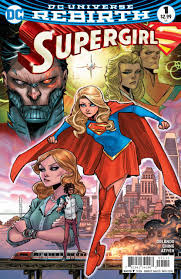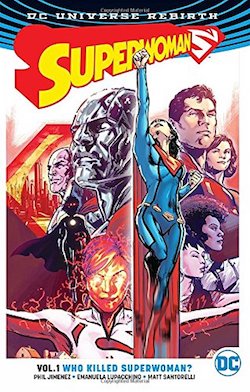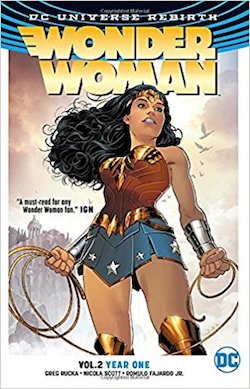Thursday Comics Hangover: Wonder Women
I haven’t had much to say about superhero movies lately — sorry, Guardians of the Galaxy Vol. 2, it’s not you, it’s me — but I do agree with the consensus that the movies made from DC Comics superheroes have been disastrous. Batman V Superman was one of the worst blockbusters I’ve ever seen. Suicide Squad was even worse. I’ll be watching the Wonder Woman movie when it debuts at Cinerama in a couple of weeks, but that feels more like an act of obligation: I want to support the first female superhero movie in a generation, even though Gal Gadot has never once ever successfully, in the technical sense of the word, acted.
The most confusing thing about the failure of DC Comics to transition to film is that there’s already a perfect prototype out there for the producers to emulate: Melissa Benoist’s performance in the weekly Supergirl TV show. In the 80s and 90s, superhero movies were always trapped in a tug-of-war between the two opposing poles of dark-n-gritty (think the first Tim Burton Batman) and campy (think the Joel Schumacher Batman Forever). Benoist’s performance as Supergirl finds a new, third way: she’s earnest but serious, happy but determined. Sure, the effects on Supergirl are cheesy, but even when it’s at its worst, Benoist’s performance holds the whole damn show together.
DC’s stable of characters — more colorful and goofy than Marvel’s — should more or less follow Benoist’s lead. These are over-the-top sci-fi concepts from the 1950s; the concern is not taking them seriously. It’s about believing in their character. Benoist gets that. The people adapting DC Comics to film, sadly, don’t.

The new collection of Supergirl comics from DC, Reign of the Cyborg Superman, unfortunately, doesn’t have Benoist’s charm, either. To the credit of writer Steve Orlando and artists Brian Ching, Emanuela Lupacchino, and Ray McCarthy, they’re rightly shooting for the optimism and the youthful vivaciousness of the TV show. Unfortunately, the comic is kind of a mess.
Reign establishes a world that mimics the basic status quo of the Supergirl TV show, introducing characters and situations that viewers will find very familiar. But it feels kind of like a mess, with some occasionally lively artwork obscured by Michael Atiyeh’s muddy coloring, and a plot that tries too hard to emulate the ALL CAPS APOCALYPSE feel of a superhero movie. The villain of the piece — Supergirl’s father, who for some reason looks like a cyborg Superman — is way too broad. But to Orlando’s credit, the book ends on a high note, with Supergirl nailing the hope and courage of her TV version. And thankfully the art doesn’t objectify Supergirl with the leering 90s male gaze that has dogged the character over the last couple decades. There’s room for improvement here.

But Supergirl isn’t the only female superhero DC is publishing these days. They’ve also got a new Superwoman character, and her first adventures are collected in a new paperback titled Who Killed Superwoman? While Supergirl is Superman’s Kryptonian cousin, the stars of Superwoman are two of superman’s love interests: Lois Lane and Lana Lang, who have both been given powers somehow — it’s not important — and who are teaming up to cover for a seemingly deceased Superman’s absence.
In case you can’t tell, there’s a lot of continuity at play in Superwoman, but you don’t have to read a dozen other books to understand what’s going on here. Writer Phil Jiminez takes a delightfully old-school approach to his superhero comics: he welcomes the weirdly intricate decades-old relationships between characters, but he also explains the important stuff to the readers in the course of the story. It’s accessible, while still hinting at the sixty years of backstory available to curious readers.
Without giving too much away, the story introduces a couple of villains unique to the book while addressing the question of what it means to do the right thing, even if it kills you. Emanuela Lupacchino’s art is better-served on this title than on Supergirl, giving her time to invest emotionally in the characters and better frame out the surroundings. Jiminez draws several issues himself in his tight, George Perez-style 80s superhero comic style. For people who’ve been reading comics for decades, it’s a throwback delight that somehow still feels like a modern superhero comic. It’s also my favorite Superman-themed book that DC has published in years, an operatic riff on values and expectations and responsibility.

DC is also publishing the original female superhero, and I’m happy to report that the second paperback of Wonder Woman comics is terrific. Just in time for the movie, writer Greg Rucka and artist Nicola Scott have told an origin story for Wonder Woman that audiences will find to be compelling and modern and fun. (Yes, even though there’s a number “2” on the spine, Year One is an origin story and can be read on its own. Sometimes comics are dumb.)
Generally, I’m against retelling origin stories in comics; my philosophy is just murder the parents in a flashback and get on with the story. But Wonder Woman has needed a good origin story for just about her entire life as a character, and Rucka succeeds where so many others have failed by making her eminently relatable.
Yes, this Wonder Woman is wildly powerful. Yes, she bests all of her fellow Amazons in hand-to-hand combat. But she’s also a total nerd, and when she first comes into contact with our modern world she can’t speak English, which gives her a relatable vulnerability. When she goes to a mall, she’s overwhelmed by all the sights and sounds and smells. (She asks a translator, “Why does the air taste this way?”) She’s tough and curious and exuberant, expecting the best and preparing for the worst.
Scott is a gifted superhero artist. She can capture difficult emotions like a flicker of nostalgia on a person’s face, but she can also draw an iconic double-page spread of Wonder Woman, her blurry arms spread out around her, octopus-like, as her bracelets deflect bullets at super-speed. Scott often draws her from below, to cast her in a heroic light, and this simple trick doesn’t feel at all manipulative or cheap; Scott conveys the sense that she’s genuinely in awe of the character she’s drawing.
A lot is riding on the Wonder Woman film. In addition to its unique status as the first-ever female-starring superhero film of the modern era, it’s also the first to be directed by a woman (Patty Jenkins, director of Monster) and the last DC superhero film to be released before this fall’s team-up film Justice League. But even if the film is a disaster — by artistic standards, by box office standards, or both — Year One proves that the character of Wonder Woman will survive. There’s a lot of humanity yet to be explored.